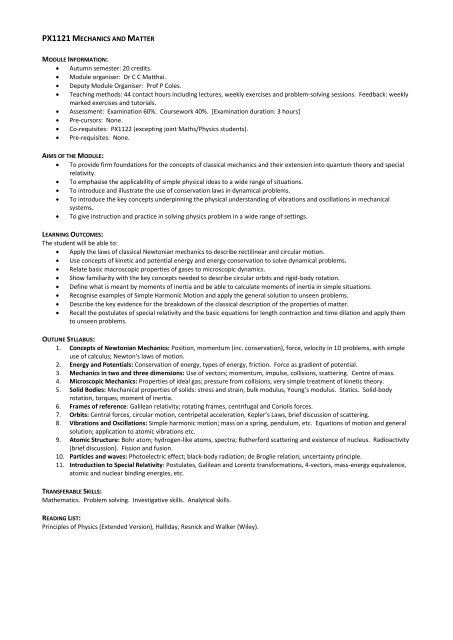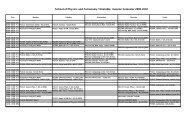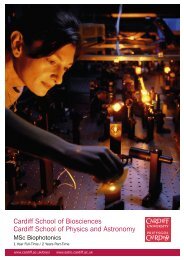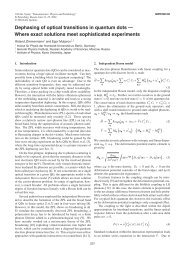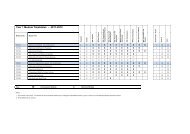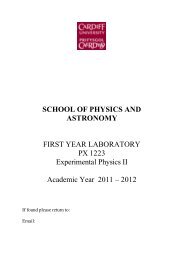PX1121 MECHANICS AND MATTER - Cardiff School of Physics and ...
PX1121 MECHANICS AND MATTER - Cardiff School of Physics and ...
PX1121 MECHANICS AND MATTER - Cardiff School of Physics and ...
You also want an ePaper? Increase the reach of your titles
YUMPU automatically turns print PDFs into web optimized ePapers that Google loves.
<strong>PX1121</strong> <strong>MECHANICS</strong> <strong>AND</strong> <strong>MATTER</strong><br />
MODULE INFORMATION:<br />
Autumn semester: 20 credits.<br />
Module organiser: Dr C C Matthai.<br />
Deputy Module Organiser: Pr<strong>of</strong> P Coles.<br />
Teaching methods: 44 contact hours including lectures, weekly exercises <strong>and</strong> problem-solving sessions. Feedback: weekly<br />
marked exercises <strong>and</strong> tutorials.<br />
Assessment: Examination 60%. Coursework 40%. [Examination duration: 3 hours]<br />
Pre-cursors: None.<br />
Co-requisites: PX1122 (excepting joint Maths/<strong>Physics</strong> students).<br />
Pre-requisites: None.<br />
AIMS OF THE MODULE:<br />
To provide firm foundations for the concepts <strong>of</strong> classical mechanics <strong>and</strong> their extension into quantum theory <strong>and</strong> special<br />
relativity.<br />
To emphasise the applicability <strong>of</strong> simple physical ideas to a wide range <strong>of</strong> situations.<br />
To introduce <strong>and</strong> illustrate the use <strong>of</strong> conservation laws in dynamical problems.<br />
To introduce the key concepts underpinning the physical underst<strong>and</strong>ing <strong>of</strong> vibrations <strong>and</strong> oscillations in mechanical<br />
systems.<br />
To give instruction <strong>and</strong> practice in solving physics problem in a wide range <strong>of</strong> settings.<br />
LEARNING OUTCOMES:<br />
The student will be able to:<br />
Apply the laws <strong>of</strong> classical Newtonian mechanics to describe rectilinear <strong>and</strong> circular motion.<br />
Use concepts <strong>of</strong> kinetic <strong>and</strong> potential energy <strong>and</strong> energy conservation to solve dynamical problems.<br />
Relate basic macroscopic properties <strong>of</strong> gases to microscopic dynamics.<br />
Show familiarity with the key concepts needed to describe circular orbits <strong>and</strong> rigid-body rotation.<br />
Define what is meant by moments <strong>of</strong> inertia <strong>and</strong> be able to calculate moments <strong>of</strong> inertia in simple situations.<br />
Recognise examples <strong>of</strong> Simple Harmonic Motion <strong>and</strong> apply the general solution to unseen problems.<br />
Describe the key evidence for the breakdown <strong>of</strong> the classical description <strong>of</strong> the properties <strong>of</strong> matter.<br />
Recall the postulates <strong>of</strong> special relativity <strong>and</strong> the basic equations for length contraction <strong>and</strong> time dilation <strong>and</strong> apply them<br />
to unseen problems.<br />
OUTLINE SYLLABUS:<br />
1. Concepts <strong>of</strong> Newtonian Mechanics: Position, momentum (inc. conservation), force, velocity in 1D problems, with simple<br />
use <strong>of</strong> calculus; Newton's laws <strong>of</strong> motion.<br />
2. Energy <strong>and</strong> Potentials: Conservation <strong>of</strong> energy, types <strong>of</strong> energy, friction. Force as gradient <strong>of</strong> potential.<br />
3. Mechanics in two <strong>and</strong> three dimensions: Use <strong>of</strong> vectors; momentum, impulse, collisions, scattering. Centre <strong>of</strong> mass.<br />
4. Microscopic Mechanics: Properties <strong>of</strong> ideal gas; pressure from collisions, very simple treatment <strong>of</strong> kinetic theory.<br />
5. Solid Bodies: Mechanical properties <strong>of</strong> solids: stress <strong>and</strong> strain, bulk modulus, Young’s modulus. Statics. Solid-body<br />
rotation, torques, moment <strong>of</strong> inertia.<br />
6. Frames <strong>of</strong> reference: Galilean relativity; rotating frames, centrifugal <strong>and</strong> Coriolis forces.<br />
7. Orbits: Central forces, circular motion, centripetal acceleration, Kepler’s Laws, brief discussion <strong>of</strong> scattering.<br />
8. Vibrations <strong>and</strong> Oscillations: Simple harmonic motion; mass on a spring, pendulum, etc. Equations <strong>of</strong> motion <strong>and</strong> general<br />
solution; application to atomic vibrations etc.<br />
9. Atomic Structure: Bohr atom; hydrogen-like atoms, spectra; Rutherford scattering <strong>and</strong> existence <strong>of</strong> nucleus. Radioactivity<br />
(brief discussion). Fission <strong>and</strong> fusion.<br />
10. Particles <strong>and</strong> waves: Photoelectric effect; black-body radiation; de Broglie relation; uncertainty principle.<br />
11. Introduction to Special Relativity: Postulates, Galilean <strong>and</strong> Lorentz transformations, 4-vectors, mass-energy equivalence,<br />
atomic <strong>and</strong> nuclear binding energies, etc.<br />
TRANSFERABLE SKILLS:<br />
Mathematics. Problem solving. Investigative skills. Analytical skills.<br />
READING LIST:<br />
Principles <strong>of</strong> <strong>Physics</strong> (Extended Version), Halliday, Resnick <strong>and</strong> Walker (Wiley).
PX1122 MATHEMATICAL METHODS FOR PHYSICISTS I<br />
MODULE INFORMATION:<br />
Autumn semester: 10 credits.<br />
Module organiser: Pr<strong>of</strong> B S Sathyaprakash.<br />
Deputy Module Organiser: Dr E Pascale.<br />
Teaching <strong>and</strong> feedback methods: Lectures 22 x 1 hr, weekly exercise classes, marked exercises.<br />
Assessment: Examination 60%. Coursework 40%. [Examination duration: 2 hours]<br />
Pre-cursors: None.<br />
Co-requisites: None.<br />
Pre-requisites: None.<br />
AIMS OF THE MODULE:<br />
To provide the basic theoretical techniques required during first-year physics courses.<br />
To introduce post-A-Level students to vectors, matrices, series, functions <strong>and</strong> graphs, <strong>and</strong> elementary calculus.<br />
To give students practice in applying mathematical techniques to abstract <strong>and</strong> physical problems.<br />
LEARNING OUTCOMES:<br />
The student will be able to:<br />
Use vectors to describe positional coordinates <strong>and</strong> lines <strong>and</strong> relate them to Cartesian coordinates <strong>and</strong> show pr<strong>of</strong>iciency at<br />
basic vector operations <strong>and</strong> scalar <strong>and</strong> vector products <strong>and</strong> their applications. Application <strong>of</strong> vector algebra to solve<br />
simple problems in physics.<br />
Demonstrate an underst<strong>and</strong>ing <strong>of</strong> how to perform <strong>and</strong> exploit basic matrix manipulations.<br />
Show familiarity with <strong>and</strong> make use <strong>of</strong> series <strong>and</strong> expansions <strong>of</strong> trigonometric, exponential <strong>and</strong> logarithmic functions.<br />
Show pr<strong>of</strong>iciency in plotting graphs <strong>of</strong> functions <strong>and</strong> their derivatives <strong>and</strong> at differentiation, partial differentiation <strong>and</strong><br />
integration <strong>and</strong> their applications.<br />
OUTLINE SYLLABUS:<br />
1. Vectors. Cartesian vectors. Importance in physics. Position. Force. Acceleration. Velocity, etc.<br />
2. Operations on Vectors. Dot <strong>and</strong> cross product. Angular momentum.<br />
3. Physical interpretation <strong>and</strong> examples <strong>of</strong> vectors.<br />
4. Matrices. Definition <strong>and</strong> interpretation. Addition <strong>and</strong> multiplication. Matrices operating on vectors, e.g. rotation in the<br />
plane.<br />
5. Inverse <strong>of</strong> a matrix. Determinants. Use for solving simultaneous equations. Symmetric, anti-symmetric <strong>and</strong> orthogonal<br />
matrices. Eigenvectors <strong>and</strong> eigenvalues for symmetric matrices.<br />
6. Functions <strong>of</strong> a real variable. Exponential, trigonometric <strong>and</strong> hyperbolic functions. Physical examples. Series expansions.<br />
Binomial <strong>and</strong> Taylor series. Approximations using truncated series.<br />
7. Differentiation <strong>of</strong> powers, logarithms, exponential <strong>and</strong> trigonometric functions. Product, quotient <strong>and</strong> chain rules. Implicit<br />
<strong>and</strong> parametric differentiation.<br />
8. Integration <strong>of</strong> powers, logarithms, exponential <strong>and</strong> trigonometric functions. Definite <strong>and</strong> indefinite integrals.<br />
9. Area under a curve. Transforming variables. Integration by parts.<br />
10. Line integrals, multiple integrals, volumes. Curvilinear coordinates, e.g. spherical polar coordinates, introduced through<br />
volume elements.<br />
11. Solution <strong>of</strong> linear first-order ODEs by separation <strong>of</strong> variables <strong>and</strong> by integrating factor.<br />
TRANSFERABLE SKILLS:<br />
Mathematics. Problem solving. Analytical skills.<br />
READING LIST:<br />
Modern Engineering Mathematics, G James (Addison Wesley).<br />
Mathematical Methods for <strong>Physics</strong> <strong>and</strong> Engineering, K F Riley, M P Hobson <strong>and</strong> S J Bence (Cambridge University Press).
PX1123 EXPERIMENTAL PHYSICS I<br />
MODULE INFORMATION:<br />
Autumn semester: 10 credits.<br />
Module organiser: Dr C Tucker.<br />
Deputy Module Organiser: Dr O Williams.<br />
Teaching <strong>and</strong> feedback methods: Year 1 laboratory 11 x 4 hr, marked weekly work <strong>and</strong> one formal report.<br />
Assessment: Continuous assessment 100%.<br />
Pre-cursors: None.<br />
Co-requisites: None.<br />
Pre-requisites: None.<br />
AIMS OF THE MODULE:<br />
To develop practical experimental <strong>and</strong> analytical skills through weekly structured laboratory sessions.<br />
To introduce select concepts <strong>of</strong> optics, scientific instrumentation <strong>and</strong> electronics.<br />
To introduce skills relating to the written communication <strong>of</strong> scientific information.<br />
Through select experiments to reinforce important physics concepts.<br />
LEARNING OUTCOMES:<br />
The student will be able to:<br />
Demonstrate their practical ability by individually managing <strong>and</strong> conducting a range <strong>of</strong> experimental tasks in four-hour<br />
weekly laboratory sessions.<br />
Demonstrate awareness <strong>of</strong> safety issues for example through writing risk assessments.<br />
Produce a laboratory diary (assessed weekly) in which he/she records their measurements <strong>and</strong> observations, analyses<br />
data <strong>and</strong> draws conclusions.<br />
Determine best estimates for true values <strong>and</strong> r<strong>and</strong>om errors from multiple measurements <strong>of</strong> the same point or data<br />
represented by a h<strong>and</strong>-drawn straight line graph.<br />
Compare measured <strong>and</strong> theoretical Gaussian data distributions <strong>and</strong> extract statistical parameters.<br />
Determine whether a significant systematic error is present by comparison with known values.<br />
Write an assessed formal report, in a scientific style, based on one <strong>of</strong> the experiments conducted during the semester.<br />
OUTLINE SYLLABUS:<br />
Induction <strong>and</strong> an introduction to interpreting data.<br />
Experiments (subject to change):<br />
Young’s modulus<br />
Coefficients <strong>of</strong> friction<br />
Variations <strong>of</strong> resistance with temperature<br />
The cathode ray oscilloscope <strong>and</strong> circuit construction<br />
Optical diffraction<br />
Computer data logging <strong>and</strong> RC circuits<br />
Statistics <strong>of</strong> experimental data (Gaussian distribution)<br />
Propagation <strong>of</strong> sound in gases<br />
AC to DC conversion using diode circuits<br />
Microwaves<br />
TRANSFERABLE SKILLS:<br />
Practical physics. Verbal <strong>and</strong> written skills. Investigative skills. Computing skills. Analytical skills. Ethical behaviour.<br />
READING LIST:<br />
Practical <strong>Physics</strong>, G L Squires, 4th Edition (Cambridge).<br />
Principles <strong>of</strong> <strong>Physics</strong> (Extended Version), Halliday, Resnick <strong>and</strong> Walker (Wiley).<br />
Laboratory manual.<br />
NOTES:<br />
This module can be <strong>of</strong>fered as a FSM.<br />
It is a requirement that this module is passed in order to progress on all PHYSX programmes.
PX1124 THE UNIVERSE FROM PARTICLES TO GALAXIES<br />
MODULE INFORMATION:<br />
Autumn semester: 10 credits.<br />
Module organiser: Dr P Hargrave.<br />
Deputy Module Organiser: Dr H L Gomez.<br />
Teaching <strong>and</strong> feedback methods: Lectures 22 x 1 hr, marked exercises.<br />
Assessment: Examination 80%. Coursework 20%. [Examination duration: 2 hours]<br />
Pre-cursors: None.<br />
Co-requisites: None.<br />
Pre-requisites: None.<br />
AIMS OF THE MODULE:<br />
To give an overview <strong>of</strong> the observed structure <strong>of</strong> stars, galaxies <strong>and</strong> the Universe.<br />
To give a simple descriptive account <strong>of</strong> the basic properties <strong>of</strong> matter, including nuclear <strong>and</strong> elementary particles.<br />
To introduce students to the application <strong>of</strong> physical <strong>and</strong> mathematical laws in formulating theories for the origin <strong>and</strong><br />
evolution <strong>of</strong> astronomical structures.<br />
LEARNING OUTCOMES:<br />
The student will be able to:<br />
Describe key developments in the history <strong>of</strong> astronomy.<br />
Explain the principles <strong>and</strong> design <strong>of</strong> astronomical telescopes.<br />
Identify <strong>and</strong> describe the physical properties <strong>of</strong> stars (distances, masses, magnitudes, temperatures).<br />
Describe the elementary structure <strong>of</strong> stars <strong>and</strong> stellar evolution <strong>and</strong> demonstrate basic knowledge <strong>of</strong> binary stars,<br />
supernovae <strong>and</strong> pulsars.<br />
Explain the basic structure <strong>of</strong> galaxies <strong>and</strong> the basic ideas <strong>of</strong> elementary cosmology.<br />
Relate key properties <strong>of</strong> stars <strong>and</strong> galaxies to the fundamental properties <strong>of</strong> matter.<br />
Demonstrate underst<strong>and</strong>ing <strong>of</strong> the physical make up <strong>of</strong> the Universe by answering both essay-style questions <strong>and</strong> solving<br />
unseen numerical problems under examination conditions.<br />
OUTLINE SYLLABUS:<br />
Introduction to Astronomy: Historical background. Ancient astronomy. Scientific astronomy: Copernicus, Tycho Brahe, Kepler,<br />
Galileo <strong>and</strong> Newton, including brief discussion <strong>of</strong> Kepler’s laws (circular orbits only).<br />
Light <strong>and</strong> telescopes: The EM spectrum. Black body radiation. Background radiation. Principles <strong>of</strong> telescope design <strong>and</strong><br />
instrumentation.<br />
The Sun <strong>and</strong> Stars: The magnitude system. Parallax. Inverse square law for flux <strong>and</strong> the distance modulus. The luminosity function<br />
<strong>of</strong> stars. The HR diagram.<br />
Nuclear burning: Nuclear matter (brief history). Energy production in stars. Main-sequence life.<br />
Stellar evolution: The birth <strong>of</strong> stars <strong>and</strong> the inter-stellar medium. The life <strong>and</strong> death <strong>of</strong> stars. Supernovae, Neutron Stars (Pulsars)<br />
<strong>and</strong> Black holes.<br />
Our galaxy: The Milky Way, rotation curves, the local group.<br />
Distances in the Universe: Measuring astronomical distances. Hubble’s law. Cosmological distances. Galaxies.<br />
Cosmology: The creation <strong>and</strong> fate <strong>of</strong> the Universe. Simple models <strong>of</strong> the Universe. Missing mass. Particle physics <strong>and</strong> dark matter.<br />
The twin frontiers <strong>of</strong> physics.<br />
TRANSFERABLE SKILLS:<br />
Problem solving. Investigative skills. Mathematics. Analytical skills.<br />
READING LIST:<br />
Introductory Astronomy <strong>and</strong> Astrophysics, Zeilik <strong>and</strong> Gregory (Saunders College Publishing).<br />
Universe, W Kaufmann (Freeman).<br />
NOTES:<br />
This module can be <strong>of</strong>fered as a FSM. External c<strong>and</strong>idates for this module are advised to have taken A-Level Mathematics.
PX1125 MATHEMATICAL PRACTICE FOR PHYSICAL SCIENCES<br />
MODULE INFORMATION:<br />
Autumn semester: 10 credits.<br />
Module organiser: Dr R M Smith.<br />
Deputy Module Organiser: Dr E A Muljarov.<br />
Teaching <strong>and</strong> feedback methods: Lectures 11 x 1 hr, examples classes 22 x 1 hr, marked exercises.<br />
Assessment: Examination 60%. Coursework 40%. [Examination duration: 2 hours]<br />
Pre-cursors: None.<br />
Co-requisites: None.<br />
Pre-requisites: None.<br />
AIMS OF THE MODULE:<br />
To provide practice at important elementary mathematical techniques.<br />
To strengthen <strong>and</strong> develop manipulative <strong>and</strong> analytical techniques learnt at AS <strong>and</strong> A level.<br />
To apply mathematical skills in the context <strong>of</strong> physics.<br />
LEARNING OUTCOMES:<br />
The student will be able to:<br />
Manipulate, simplify <strong>and</strong> sketch simple functions.<br />
Find the derivatives <strong>of</strong> simple functions.<br />
Find the indefinite or definite integrals <strong>of</strong> simple functions.<br />
Find the general solution or particular solutions <strong>of</strong> simple differential equations using the techniques <strong>of</strong> direct integration<br />
<strong>and</strong> separation <strong>of</strong> variables.<br />
Perform basic manipulations <strong>of</strong> vectors <strong>and</strong> complex numbers.<br />
Calculate the permutations <strong>and</strong> combinations for selecting from objects <strong>and</strong> underst<strong>and</strong> the distinction between<br />
them.<br />
Write out the Binomial expansion for expressions <strong>of</strong> the form .<br />
Recognise <strong>and</strong> be able to find the sum <strong>of</strong> arithmetic <strong>and</strong> geometric progressions.<br />
OUTLINE SYLLABUS:<br />
Weekly worksheets<br />
Algebra<br />
Logarithms <strong>and</strong> exponentials<br />
Differentiation I<br />
Differentiation II<br />
Integration I<br />
Integration II<br />
Differential equations<br />
Determinants <strong>and</strong> vectors<br />
Complex numbers<br />
Permutations <strong>and</strong> combinations, binomial <strong>and</strong> other series<br />
TRANSFERABLE SKILLS:<br />
Problem solving. Mathematics. Analytical skills.<br />
READING LIST:<br />
Modern Engineering Mathematics, G James (Addison-Wesley Publishing).<br />
Mathematical Methods for <strong>Physics</strong> <strong>and</strong> Engineering, K F Riley, M P Hobson <strong>and</strong> S J Bence (Cambridge University Press).<br />
Less advanced books <strong>of</strong> use in support <strong>of</strong> this module:<br />
Maths: A Students’ Survival Guide, J Olive (Cambridge University Press).<br />
Core Maths for A-Level, L Bostock <strong>and</strong> S C<strong>and</strong>ler (Stanley Thornes Publishers).<br />
Engineering Mathematics, K A Stroud (Palgrave).
PX1221 ELECTRICITY, MAGNETISM <strong>AND</strong> WAVES<br />
MODULE INFORMATION:<br />
Spring semester: 20 credits.<br />
Module organiser: Dr J I Davies.<br />
Deputy Module Organiser: Pr<strong>of</strong> P Coles.<br />
Teaching methods: 44 contact hours including lectures, weekly exercises <strong>and</strong> problem-solving sessions. Feedback: weekly<br />
marked exercises <strong>and</strong> tutorials.<br />
Assessment: Examination 60%. Coursework 40%. [Examination duration: 3 hours]<br />
Pre-cursors: PX1122 (excepting joint Maths/<strong>Physics</strong> students).<br />
Co-requisites: PX1222 (excepting joint Maths/<strong>Physics</strong> students).<br />
Pre-requisites: None.<br />
AIMS OF THE MODULE:<br />
To introduce the mathematical language <strong>of</strong> waves to describe wave formation, wave propagation <strong>and</strong> interference <strong>and</strong><br />
diffraction.<br />
To examine matter at an atomic level to give insight into crystal bonding <strong>and</strong> the electrical, thermal <strong>and</strong> mechanical<br />
properties <strong>of</strong> matter.<br />
To introduce concepts <strong>of</strong> electrostatics, <strong>of</strong> magnetic fields associated with currents <strong>and</strong> <strong>of</strong> electromagnetic induction to<br />
provide a firm foundation for the study <strong>of</strong> electromagnetism in Year 2.<br />
To provide insight into forced vibration <strong>and</strong> resonance through examples <strong>of</strong> AC theory <strong>and</strong> mechanical analogues.<br />
To give instruction <strong>and</strong> practice in solving physics problem.<br />
LEARNING OUTCOMES:<br />
The student will be able to:<br />
Distinguish between different wave types <strong>and</strong> describe wave <strong>and</strong> energy propagation mathematically in one or more<br />
dimensions.<br />
Apply boundary conditions to wave equations to determine the formation <strong>of</strong> st<strong>and</strong>ing waves in strings <strong>and</strong> pipes <strong>and</strong><br />
explain refraction.<br />
Demonstrate an underst<strong>and</strong>ing <strong>of</strong> interference <strong>and</strong> diffraction, including crystal diffraction.<br />
Describe the distinguishing features between conductors, insulators <strong>and</strong> semiconductors.<br />
Discuss phase changes in matter.<br />
Describe the origin <strong>and</strong> nature <strong>of</strong> the various forces <strong>and</strong> fields associated with static <strong>and</strong> moving charges.<br />
Recall the basic laws <strong>of</strong> electromagnetism <strong>and</strong> use integration methods to apply Coulomb’s law <strong>and</strong> the Biot-Savart law to<br />
complex systems <strong>of</strong> charges or circuits.<br />
Derive basic equations for free <strong>and</strong> forced oscillations <strong>of</strong> damped electrical <strong>and</strong> mechanical systems using both real <strong>and</strong><br />
complex notation.<br />
OUTLINE SYLLABUS:<br />
1. Waves: Classification <strong>of</strong> waves. One-dimensional non-dispersive waves. D’Alembert’s solution. Harmonic waves.<br />
Derivation <strong>of</strong> the wave equation for transverse waves on a string. Energy density <strong>and</strong> power flow in a travelling wave.<br />
2. Refraction <strong>and</strong> dispersion: Plane waves at boundaries. Refraction <strong>and</strong> Snell’s laws. Refracting optics. Dispersion.<br />
3. Superposition: Beats. Longitudinal waves in solids <strong>and</strong> sound waves. Sound intensity. Spherical waves <strong>and</strong> the inverse<br />
square law. St<strong>and</strong>ing waves. Interference <strong>and</strong> diffraction. Examples.<br />
4. Waves <strong>and</strong> matter: Light interaction with matter <strong>and</strong> elementary spectroscopy (Bohr theory). Diffraction studies <strong>of</strong><br />
solids, leading to atoms, bonding <strong>and</strong> crystal structure.<br />
5. Electronic properties <strong>of</strong> matter: Electrical properties <strong>of</strong> materials – conductors, insulators <strong>and</strong> semiconductors. Free<br />
electrons, energy b<strong>and</strong>s <strong>and</strong> b<strong>and</strong> gaps. Semiconductor doping <strong>and</strong> the p-n junction.<br />
6. Coulomb’s <strong>and</strong> Gauss’s Laws: Electric charge <strong>and</strong> Coulomb’s law. E <strong>and</strong> V fields. Field lines <strong>and</strong> forces. Electric flux.<br />
Gauss’ law. Examples <strong>of</strong> charge distributions, including sphere <strong>and</strong> line.<br />
7. Capacitance: Electric potential, potential difference, relationship between E <strong>and</strong> V. Electric energy <strong>and</strong> energy density.<br />
Capacitance. Dielectrics. Energy stored on a capacitor. Capacitance <strong>of</strong> sphere <strong>and</strong> coaxial cable.<br />
8. Electricity <strong>and</strong> magnetism: Conductivity, resistivity <strong>and</strong> resistance. Electrical power. Magnetic effects <strong>of</strong> current-carrying<br />
wires. Magnetic field lines, flux <strong>and</strong> Lorenz force. Biot-Savart law <strong>and</strong> applications. Torque on a current loop.<br />
9. Electromagnetic induction: Faraday’s law <strong>and</strong> electromagnetic induction. Mutual <strong>and</strong> self inductance. Inductors.<br />
10. AC Theory: Circuit elements: R, C <strong>and</strong> L. RMS. Power factors. LCR circuits. Rotating vector <strong>and</strong> complex-exponential<br />
representation. Phasor diagrams.<br />
11. Resonance: Damped free vibrations. Light, heavy <strong>and</strong> critical damping. Quality factor. Forced vibration. Response<br />
functions: displacement amplitude <strong>and</strong> phase as a function <strong>of</strong> frequency. Absorbed power. Steady-state <strong>and</strong> transient<br />
solutions. Electrical <strong>and</strong> mechanical analogues.<br />
TRANSFERABLE SKILLS:<br />
Mathematics. Problem solving. Investigative skills. Analytical skills.
READING LIST:<br />
Principles <strong>of</strong> <strong>Physics</strong> (Extended Version), Halliday, Resnick <strong>and</strong> Walker (Wiley).
PX1222 MATHEMATICAL METHODS FOR PHYSICISTS II<br />
MODULE INFORMATION:<br />
Spring semester: 10 credits.<br />
Module organiser: Dr E Pascale.<br />
Deputy Module Organiser: Pr<strong>of</strong> B S Sathyaprakash.<br />
Teaching <strong>and</strong> feedback methods: Lectures 22 x 1 hr, weekly exercise classes, marked exercises.<br />
Assessment: Examination 60%. Coursework 40%. [Examination duration: 2 hours]<br />
Pre-cursors: PX1122 (excepting joint Maths/<strong>Physics</strong> students).<br />
Co-requisites: None.<br />
Pre-requisites: None.<br />
AIMS OF THE MODULE:<br />
To provide the basic theoretical techniques required during first-year physics courses.<br />
To give post-A-Level students a solid grounding in complex numbers, vector calculus, second-order differential equations,<br />
matrices <strong>and</strong> basic probability theory.<br />
To give students practice in applying mathematical techniques to abstract <strong>and</strong> physical problems.<br />
LEARNING OUTCOMES:<br />
The student will be able to:<br />
Demonstrate pr<strong>of</strong>iciency at basic representations, operations <strong>and</strong> applications <strong>of</strong> complex numbers.<br />
Demonstrate an underst<strong>and</strong>ing <strong>of</strong> the meaning <strong>of</strong> scalar <strong>and</strong> vector fields, <strong>and</strong> demonstrate the application <strong>of</strong> grad, div,<br />
curl, Laplacian to the formulation <strong>of</strong> the laws <strong>of</strong> physics.<br />
Set up <strong>and</strong> solve simple first-order differential equations.<br />
Show pr<strong>of</strong>iciency in using techniques for solving first- <strong>and</strong> second-order differential equations.<br />
Show familiarity with basic probability distributions, statistical measures <strong>and</strong> their use.<br />
OUTLINE SYLLABUS:<br />
1. Arg<strong>and</strong> diagrams. Polar <strong>and</strong> Euler representations. De Moivre’s theorem. Complex functions. Physical applications <strong>of</strong><br />
complex numbers. Relationship to 2D vectors <strong>and</strong> matrices.<br />
2. Differentiation <strong>of</strong> a vector. Gradient vector. Conservative <strong>and</strong> non-conservative fields. Examples from physics.<br />
Differentiation <strong>of</strong> a function <strong>of</strong> more than one variable.<br />
3. Partial differentiation. Idea <strong>of</strong> div, grad <strong>and</strong> curl (briefly). Stationary values, maxima <strong>and</strong> minima. Conditional stationary<br />
values.<br />
4. Ordinary differential equations in physics. Setting up physical problems. General classification <strong>of</strong> ODEs. Superposition<br />
theorems. Boundary conditions<br />
5. Second-order linear homogeneous equations. Examples.<br />
6. Second-order linear inhomogeneous equations. Particular integrals <strong>and</strong> complementary functions. Trial solutions. Simple<br />
harmonic examples, use <strong>of</strong> .<br />
7. Introduction to Fourier series.<br />
8. Partial differential equations in physics. Examples (brief): Wave equation, heat equation, diffusion, Schrodinger equation.<br />
9. Separation <strong>of</strong> variables method <strong>of</strong> solving PDE.<br />
10. Probability Axioms. Discrete Events. Probability Distributions. Binomial <strong>and</strong> Poisson distributions.<br />
11. Normal distribution, r<strong>and</strong>om walks <strong>and</strong> diffusion. Means <strong>and</strong> variances. Relevance to statistical treatment <strong>of</strong> errors.<br />
TRANSFERABLE SKILLS:<br />
Problem solving. Investigative skills. Mathematics. Analytical skills.<br />
READING LIST:<br />
Modern Engineering Mathematics, G James (Addison Wesley).<br />
Mathematical Methods for <strong>Physics</strong> <strong>and</strong> Engineering, K F Riley, M P Hobson <strong>and</strong> S J Bence (Cambridge University Press).
PX1223 EXPERIMENTAL PHYSICS II<br />
MODULE INFORMATION:<br />
Spring semester: 10 credits.<br />
Module organiser: Dr C Tucker.<br />
Deputy Module Organiser: Dr O Williams.<br />
Teaching <strong>and</strong> feedback methods: Year 1 laboratory 11 x 4 hr, marked weekly work <strong>and</strong> one formal report.<br />
Assessment: Continuous assessment 100%.<br />
Pre-cursors: PX1123.<br />
Co-requisites: None.<br />
Pre-requisites: None.<br />
AIMS OF THE MODULE:<br />
To develop practical experimental <strong>and</strong> analytical skills through weekly structured laboratory sessions.<br />
To introduce select concepts <strong>of</strong> optics, scientific instrumentation <strong>and</strong> electronics.<br />
To introduce skills relating to the written communication <strong>of</strong> scientific information.<br />
Through select experiments to reinforce important physics concepts.<br />
LEARNING OUTCOMES:<br />
The student will be able to:<br />
Demonstrate their practical ability by individually managing <strong>and</strong> conducting a range <strong>of</strong> experimental tasks in four-hour<br />
weekly laboratory sessions.<br />
Demonstrate awareness <strong>of</strong> safety issues for example through writing risk assessments.<br />
Produce a laboratory diary (assessed weekly) in which he/she records their measurements <strong>and</strong> observations, analyses<br />
data <strong>and</strong> draws conclusions.<br />
Use a computer program to determine best estimates for true values <strong>and</strong> r<strong>and</strong>om errors from data represented by a<br />
straight line graph.<br />
Compare measurements from counting experiments with theoretical Poisson distributions data distributions <strong>and</strong> extract<br />
statistical parameters.<br />
Determine whether a significant systematic error is present by comparison with known values.<br />
Write an assessed formal report, in a scientific style, based on one <strong>of</strong> the experiments conducted during the semester.<br />
OUTLINE SYLLABUS:<br />
Experiments (subject to change):<br />
Measurement <strong>of</strong> e/m<br />
Planck’s constant<br />
A-C Circuits<br />
Radioactive decay with Poisson Theory<br />
X-rays<br />
Lens systems <strong>and</strong> Telescopes<br />
Bragg X-ray Studies <strong>of</strong> Solids<br />
Vibrations <strong>and</strong> resonance (in electrical circuits)<br />
Hubble Constant<br />
Current Balance<br />
TRANSFERABLE SKILLS:<br />
Practical physics. Verbal <strong>and</strong> written skills. Investigative skills. Computing skills. Analytical skills. Ethical behaviour.<br />
READING LIST:<br />
Practical <strong>Physics</strong>, G L Squires, 4th Edition (Cambridge).<br />
Principles <strong>of</strong> <strong>Physics</strong> (Extended Version), Halliday, Resnick <strong>and</strong> Walker (Wiley).
PX1224 COMPUTATIONAL SKILLS FOR PROBLEM SOLVING<br />
MODULE INFORMATION:<br />
Autumn semester, 10 credits.<br />
Module organiser: Dr S Fairhurst.<br />
Deputy Module Organiser: Dr W F Grainger.<br />
Teaching <strong>and</strong> feedback methods: Computing laboratory 11 x 2 hr. Marked exercises <strong>and</strong> assignments.<br />
Assessment: Continuous assessment 100%.<br />
Pre-cursors: <strong>PX1121</strong>.<br />
Co-requisites: PX1221.<br />
Pre-requisites: None.<br />
AIMS OF THE MODULE:<br />
To give instruction on <strong>and</strong> provide practice in the use <strong>of</strong> computers to develop basic data h<strong>and</strong>ling skills required by<br />
physical scientists (e.g. graphing <strong>and</strong> data analysis skills).<br />
To develop the basic numerical computing skills required by physical scientists.<br />
To develop pr<strong>of</strong>iciency in problem solving by working through a series <strong>of</strong> examples which relate to the experimental <strong>and</strong><br />
taught physics modules.<br />
LEARNING OUTCOMES:<br />
The student will be able to:<br />
Enter or read in data from files (in st<strong>and</strong>ard formats); plot <strong>and</strong> export graphs suitable for inclusion in a report.<br />
Perform statistical analysis <strong>of</strong> data <strong>of</strong> the form ; best fit <strong>and</strong> error determinations.<br />
Use <strong>and</strong> manipulate simple mathematical functions in Python.<br />
Express mathematical integration <strong>and</strong> differentiation problems such that they may be solved numerically.<br />
Use numerical techniques with Python to solve a number <strong>of</strong> mathematical <strong>and</strong> physical problems.<br />
OUTLINE SYLLABUS:<br />
Introduction: Data analysis <strong>and</strong> numerical techniques via computing with Python.<br />
Graphing skills: Reading in <strong>and</strong> entering x-y data, data plotting, fitting with straight line (including error determination).<br />
R<strong>and</strong>om numbers: Generation. Application to the generation <strong>of</strong> distributions (including plotting histograms).<br />
Using mathematical functions: Use <strong>of</strong> basic mathematical functions (sine, exp etc.); introduction to more advanced functions.<br />
Simple numerical integration <strong>and</strong> differentiation: Numerical techniques <strong>and</strong> the importance <strong>of</strong> step size. These will practiced (<strong>and</strong><br />
tested) mainly by application to basic mathematical functions.<br />
Application <strong>of</strong> Numerical Methods: Approaches to solving physics problems, e.g. modelling the simple pendulum, projectile motion<br />
through a viscous medium, analysing real experimental data.<br />
TRANSFERABLE SKILLS:<br />
Problem solving. Mathematics. Analytical skills. Computational skills.<br />
READING LIST:<br />
Principles <strong>of</strong> <strong>Physics</strong> (Extended Version), Halliday, Resnick <strong>and</strong> Walker (Wiley).
PX1225 PLANETS <strong>AND</strong> EXOPLANETS<br />
MODULE INFORMATION:<br />
Spring semester: 10 credits.<br />
Module organiser: Pr<strong>of</strong> D Ward-Thompson.<br />
Deputy Module Organiser: Pr<strong>of</strong> S A Eales.<br />
Teaching <strong>and</strong> feedback methods: Lectures 22 x 1 hr, marked exercises.<br />
Assessment: Examination 80%. Coursework 20%. [Examination duration: 2 hours]<br />
Pre-cursors: None.<br />
Co-requisites: None.<br />
Pre-requisites: None.<br />
AIMS OF THE MODULE:<br />
To introduce the basic constituents <strong>of</strong> the solar system, their orbits <strong>and</strong> physical properties.<br />
To describe the physical properties <strong>of</strong> planetary surfaces <strong>and</strong> atmospheres.<br />
To interpret these properties in terms <strong>of</strong> physical theory.<br />
To introduce the various observational methods <strong>of</strong> proto-planet <strong>and</strong> exoplanet detection.<br />
To introduce the basic ideas behind the current theories <strong>of</strong> planet formation <strong>and</strong> how they are related to observed<br />
properties <strong>of</strong> the Solar System <strong>and</strong> extra-solar planets.<br />
LEARNING OUTCOMES:<br />
The student will be able to:<br />
Use the principle <strong>of</strong> hydrostatic equilibrium to model the internal structures <strong>and</strong> shapes <strong>of</strong> planets.<br />
Describe the properties <strong>of</strong> planetary systems in terms <strong>of</strong> basic physical concepts, such as tidal forces.<br />
Evaluate <strong>and</strong> discuss the observational arguments in favour <strong>of</strong> the st<strong>and</strong>ard model for the formation <strong>of</strong> planetary systems.<br />
Demonstrate their underst<strong>and</strong>ing <strong>of</strong> planetary systems by answering both essay-style questions <strong>and</strong> solving unseen<br />
numerical problems under examination conditions<br />
OUTLINE SYLLABUS:<br />
The Solar System: Kepler’s laws <strong>of</strong> planetary motion. Elliptical orbits. Applications to planets, moons <strong>and</strong> comets. Structure, age<br />
<strong>and</strong> composition <strong>of</strong> objects in the Solar System. A basic model for the formation <strong>of</strong> the Solar System. Existence <strong>of</strong> Lagrange points.<br />
Space travel; transfer orbits.<br />
Planetary Structure <strong>and</strong> Surfaces: Atmospheres. Hydrostatic equilibrium. Plane-parallel atmosphere. Tides <strong>and</strong> tidal forces.<br />
Roche limit. Ring systems. Comparative planetology. Terrestrial planets <strong>and</strong> gas giants. The structures <strong>of</strong> planets from satellite<br />
orbits <strong>and</strong> precession, seismic waves <strong>and</strong> plate tectonics.<br />
Comets <strong>and</strong> Asteroids: The properties <strong>of</strong> comets. The Oort cloud. The Kuiper belt. Plutinos. Evidence for impacts <strong>and</strong> the<br />
extinction <strong>of</strong> the dinosaurs. Near-Earth objects.<br />
Extra-solar Planets: Detection methods. Properties <strong>of</strong> exoplanets. The habitable zone. Protoplanetary systems <strong>and</strong> theories <strong>of</strong><br />
planet formation. The Drake equation.<br />
TRANSFERABLE SKILLS:<br />
Problem solving. Investigative skills. Mathematics. Analytical skills.<br />
READING LIST:<br />
Origins: How the Planets, Stars, Galaxies, <strong>and</strong> the Universe Began, S A Eales (Springer).<br />
NOTES:<br />
This module can be <strong>of</strong>fered as a FSM.
PX1226 HOW THE HUMAN BODY WORKS<br />
MODULE INFORMATION:<br />
Spring semester: 10 credits.<br />
Module organiser: Dr N D Pugh.<br />
Deputy Module Organiser: Dr R J Morris.<br />
Teaching <strong>and</strong> feedback methods: Lectures 22 x 1 hr, exercises.<br />
Assessment: Examination 80%. Coursework 20%. [Examination duration: 2 hours]<br />
Pre-cursors: None.<br />
Co-requisites: None.<br />
Pre-requisites: None.<br />
AIMS OF THE MODULE:<br />
To provide to students <strong>of</strong> physics an introduction to human anatomy <strong>and</strong> physiology.<br />
To give an overview <strong>of</strong> the construction <strong>and</strong> function <strong>of</strong> cells, <strong>and</strong> the structure <strong>and</strong> operation <strong>of</strong> the musculoskeletal,<br />
nervous, cardiovascular, digestive <strong>and</strong> reproductive systems.<br />
To give a working knowledge <strong>of</strong> genetics <strong>and</strong> the basis <strong>of</strong> inheritance, infection <strong>and</strong> disease control.<br />
LEARNING OUTCOMES:<br />
The student will be able to:<br />
Describe the structure <strong>and</strong> function <strong>of</strong> cells <strong>and</strong> processes such as osmosis, diffusion <strong>and</strong> active transport.<br />
Explain the concepts <strong>and</strong> mechanisms <strong>of</strong> inheritance.<br />
Outline the structure <strong>and</strong> role <strong>of</strong> the musculoskeletal system.<br />
Identify key features <strong>and</strong> mechanisms <strong>of</strong> nerve cells, the nervous system <strong>and</strong> sensory perception.<br />
Describe the role <strong>of</strong> the cardiovascular system, the composition <strong>and</strong> transport <strong>of</strong> blood, <strong>and</strong> the functions <strong>of</strong> respiration.<br />
Explain the functions <strong>of</strong> the digestive <strong>and</strong> renal systems.<br />
Describe the human reproductive system, including the hormonal controls <strong>of</strong> ovarian <strong>and</strong> male reproductive function.<br />
OUTLINE SYLLABUS:<br />
Cells: Cell structure <strong>and</strong> function, DNA, proteins, carbohydrates. Cell membrane, osmosis, diffusion, active transport. Genetics,<br />
mitosis, meiosis. Inheritance, monohybrid inheritance, co-dominance, sex determination, sex linkage.<br />
Musculoskeletal System: Bone <strong>and</strong> skeletal system. Types <strong>of</strong> bone, joints. Muscles, types <strong>of</strong> muscle, mechanics <strong>of</strong> muscle<br />
contraction <strong>and</strong> joint movement.<br />
Nervous <strong>and</strong> Control Systems: Nerve cell, neuromuscular transmission, central nervous system, peripheral nervous system, sensory<br />
functions, motor functions. Endocrine system.<br />
Cardiovascular system: Blood <strong>and</strong> constituents, blood groups, heart structure <strong>and</strong> function, blood pressure, blood vessels,<br />
lymphatics <strong>and</strong> lymph, diseases <strong>of</strong> cardiovascular system. Structure <strong>of</strong> respiratory system, respiration, functions <strong>of</strong> respiration,<br />
transport <strong>of</strong> oxygen <strong>and</strong> carbon dioxide, oxygen dissociation curve, maintenance <strong>of</strong> blood pH.<br />
Urinary system: Kidney structure <strong>and</strong> function, water balance regulation.<br />
Digestive system: Structure, food <strong>and</strong> nutrition, energy balance, homeostasis.<br />
Reproductive system: Anatomy <strong>of</strong> the male reproductive system, spermatogenesis, hormonal control <strong>of</strong> male reproductive<br />
functions. Anatomy <strong>of</strong> the female reproductive system, ovarian function, control <strong>of</strong> ovarian function.<br />
TRANSFERABLE SKILLS:<br />
Problem solving. Investigative skills. Mathematics. Analytical skills.<br />
READING LIST:<br />
Any general anatomy <strong>and</strong> physiology textbook.<br />
NOTES:<br />
This module can be <strong>of</strong>fered as a FSM.


